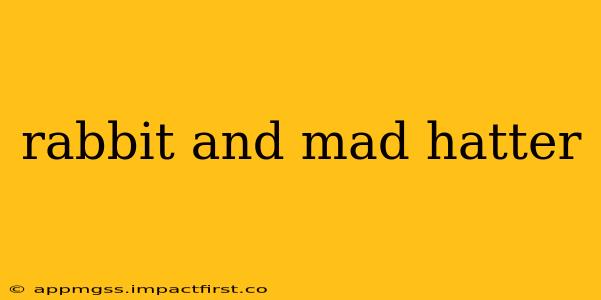Lewis Carroll's Alice's Adventures in Wonderland has captivated readers for generations, and two characters stand out as particularly memorable and enigmatic: the Mad Hatter and the White Rabbit. Their eccentricities, their symbolic weight, and their enduring presence in popular culture make them worthy of deeper exploration. This article delves into the enduring fascination surrounding these iconic characters, examining their origins, interpretations, and lasting impact.
What Makes the Mad Hatter So Mad?
The Mad Hatter's madness is, perhaps, the most discussed aspect of his character. He's not simply eccentric; his behavior reflects a deeper societal commentary. Some interpretations link his madness to mercury poisoning, a common occupational hazard for hatters in Victorian England who used mercury nitrate in the felt-making process. This theory aligns with the Hatter's erratic behavior and nonsensical pronouncements. However, the text doesn't explicitly state this, leaving room for diverse interpretations.
His tea party, a chaotic and never-ending affair, symbolizes the absurdity of social conventions and the pointless nature of rigidly adhering to outdated norms. He's a representation of societal pressures and the potential consequences of ignoring them. The Mad Hatter's madness isn't just a whimsical quirk; it's a reflection of the anxieties and contradictions of Victorian society.
Why is the White Rabbit Always Late?
The White Rabbit, with his pocket watch and frantic dash, is often seen as a symbol of the relentless pursuit of time and the pressures of modern life. His constant worry about being late reflects the anxieties associated with societal expectations and the feeling of being overwhelmed by responsibilities.
His urgency and precise nature, ironically, lead to his chaotic and unpredictable behavior. His importance is heightened by his very ordinariness, making him relatable despite his somewhat bizarre circumstances. The White Rabbit's frantic energy is a constant reminder of the ever-present pressure to maintain order and control in a world constantly in flux.
What is the Significance of the Mad Hatter's Tea Party?
The Mad Hatter's tea party is a pivotal scene, a microcosm of the nonsensical world Alice finds herself in. It's a critique of rigid social structures and the arbitrary nature of rules and customs. The never-ending tea party, with its illogical conversations and shifting guests, reflects the absurdity of meaningless rituals and social obligations. The party's chaotic nature is a powerful metaphor for the unpredictable and often frustrating aspects of life.
Beyond the social commentary, the tea party is a space of creative freedom. The characters' nonsensical dialogue and unpredictable behavior illustrate the potential for liberation found in embracing the absurd and breaking free from conventional constraints.
What Symbolism is Associated with the White Rabbit?
The White Rabbit's symbolism is multifaceted. His constant lateness underscores the human struggle with time management and the pressure to meet deadlines, mirroring the societal expectations of productivity and punctuality prevalent in Victorian England. His white color can be interpreted as a representation of purity and innocence, yet his actions are often frantic and chaotic, hinting at a hidden complexity beneath the surface.
Furthermore, the rabbit, as a creature known for disappearing quickly into its burrows, symbolizes the elusive nature of time and the fleeting moments of life. His overall presence adds to the dreamlike and surreal quality of Wonderland.
What are the differences between the Mad Hatter and the White Rabbit?
While both characters embody the strangeness of Wonderland, they differ significantly in their personalities and roles within the narrative. The Mad Hatter is eccentric, chaotic, and outwardly expressive, reveling in his nonsensical pronouncements and absurd behavior. His madness is a central theme, highlighting the societal pressures and anxieties that drove individuals to the brink.
The White Rabbit, on the other hand, is more reserved and tightly wound. His frantic energy is internally driven, fueled by his obsession with punctuality and order. He embodies the relentless pursuit of time and the anxieties associated with meeting societal expectations. Their contrasting personalities highlight the multiple facets of the chaotic and dreamlike Wonderland.
This exploration of the Mad Hatter and the White Rabbit reveals their enduring appeal and multifaceted symbolism. They serve as compelling reminders of the absurdity of life, the pressures of societal expectations, and the liberating potential of embracing the unexpected. Their enduring presence in popular culture is a testament to their impactful and memorable roles within Lewis Carroll's timeless masterpiece.
